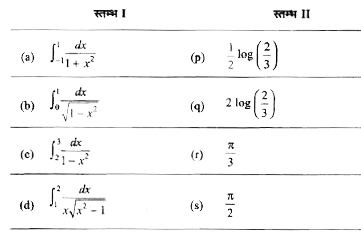हल कीजिए ∫322x5+x4−2x3+2x2+1(x2+1)(x4−1)dx
The correct Answer is:12ln6−110
Step by step video, text & image solution for हल कीजिए int_(2)^(3)(2x^(5)+x^(4)-2x^(3)+2x^(2)+1)/((x^(2)+1)(x^(4)-1))dx by Maths experts to help you in doubts & scoring excellent marks in Class 12 exams.
Updated on:21/07/2023Topper's Solved these Questions
- निश्चित समाकलन Book:JEE Main & Advanced (Hindi Medium)Chapter:निश्चित समाकलन Exercise:एकल पूर्णाक प्रश्न
Explore 7 Videos
- निश्चित समाकलन Book:JEE Main & Advanced (Hindi Medium)Chapter:निश्चित समाकलन Exercise:मैट्रिक्स-सुमेल प्रकार
Explore 1 Video
- द्विपद प्रमेयBook:JEE Main & Advanced (Hindi Medium)Chapter:द्विपद प्रमेयExercise:एकल पूर्णांक प्रश्न
Explore 3 Videos
- परवलयBook:JEE Main & Advanced (Hindi Medium)Chapter:परवलयExercise:एकल पूर्णांक प्रश्न
Explore 5 Videos
Similar Questions
दिया है कि किसी वास्तविक संख्या x के लिए [x], अधिकतम पूर्णांक को दर्शाता है यदि अन्तराल [−10,10] पर वास्तविक मानों वाला फलन f निम्न प्रकार से परिभाषित है f(x)={x−[x],if [x] is Odd,1+[x]−x, if [x] is Even तो π210∫10−10f(x)cosπxdx का मान है
View Solutionस्तम्भ I में दिए गए समाकलनो का स्तम्भ II में दिए गए मानो के साथ सुमेल कराये।

View Solution(1+x)n+5 के तीन क्रमागत पदों के गुणांक 5 : 10 : 14 के अनुपात में है, तब n का मान ज्ञात कीजिए ।
View Solutiony2=8x एक परवलय है। मान लीजिए एक त्रिभुज का क्षेत्रफल है जो नाभिलम्ब जीवा के सिरों और परवलय के बिन्दु P(12,2) द्वारा निर्मित है और Δ2 उस त्रिभुज का क्षेत्रफल है, जो बिन्दु P पर और नाभिलम्ब जीवा के सिरों पर खींची गई स्पर्शियों द्वारा बना है। तब Δ1Δ2 है।
View SolutionEvaluate : ∫1011+2x+2x2+2x3+x4dx
View Solution∫x2−1x3√2x4−2x2+1dxisequa<o √2x4−2x2+1x3+C (b) √2x4−2x2+1x+C √2x4−2x2+1x2+C (d) √2x4−2x2+12x2+C
View SolutionEvaluate: ∫322x5+x4−2x3+2x2+1(x2+1)(x4−1)dx
View SolutionThe area of the region for which is ∫31(3−2x−x2)dx (b) ∫30(3−2x−x2)dx ∫10(3−2x−x2)dx (d) ∫3−1(3−2x−x2)dx 0<y<3−2x−x2 and x>0
View Solutionint_(-(1)/(sqrt(3)))^(-(1)/(sqrt(3)))(x^(4))/(1-x^(4))cos^(-1)((2x)/(1+x^(2)))dx
View SolutionLet A=int_((3)/(4))^((4)/(3))(2x^(2)+x+1)/(x^(3)+x^(2)+x+1)dx, then find the value of e^(A).
View Solution∫24x2+x√2x+1dx=
View Solution∫302x5+x4−2x3+2x2+1(x2+1)(x4−1)dx
View SolutionIf ∫211dx(x2−2x+4)32=kk+5 then k is equal to :
View Solution∫4−1(x5+2x2+x)dx
View SolutionEvaluate ∫322x5+x4−2x3+2x2+1(x2+1)(x4−1)dx
View Solution